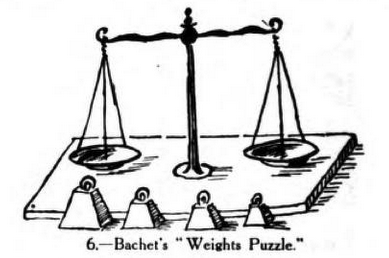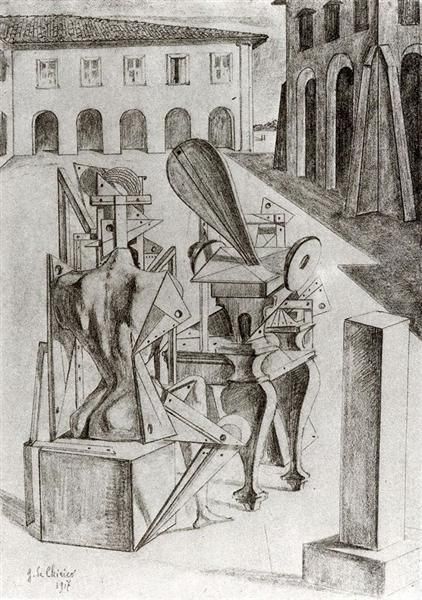Here’s another puzzle from Henry Dudeney’s article “The World’s Best Puzzles”, The Strand Magazine, December 1908. According to Dudeney, this puzzle is originally from Problèmes plaisans et délectables qui se font par les nombres (Pleasant and delectable number problems), by French mathematician Claude Gaspar Bachet de Méziriac (1551-1636).[1]

A balance scale and four weights. Image Source
You have four (integral) weights
and a balance scale such that you can weigh any object weighing from 1 lb to 40 lbs (no fractions). The weights may go on either side of the scale (eg, with the object, or in the opposite pan). What are the ?
This seems like a variation on the Frobenius coin problem, which in general is NP-hard. Fortunately, this specific instance is not.
As before, here’s Chirico’s The Mathematicians for you to look at while you try to solve this. Solution below.

The Mathematicians (1917)
Artist: Giorgio de Chirico.
Source: WikiArt
The Solution #
The four weights are (1, 3, 9, 27). Before we confirm this computationally, let’s compute the solution using induction.
Let’s rephrase the problem as
You have
weights… such that you can weigh any number of pounds in the range 1:m….
where
Then for the case
1. The weights
I’ll use
You can see from the above that the general form of the solution is
where
Let’s just see what that looks like in R:
library(poorman)
signs = c(-1, 0, 1)
S = expand.grid (s1 = signs,
s2 = signs)
knitr::kable(S)| s1 | s2 |
|---|---|
| -1 | -1 |
| 0 | -1 |
| 1 | -1 |
| -1 | 0 |
| 0 | 0 |
| 1 | 0 |
| -1 | 1 |
| 0 | 1 |
| 1 | 1 |
Let’s take the linear combination of s1 and s2, using the weights
(1, 3).
S = S |>
mutate(x = 1 * s1 + 3 *s2)
knitr::kable(S)| s1 | s2 | x |
|---|---|---|
| -1 | -1 | -4 |
| 0 | -1 | -3 |
| 1 | -1 | -2 |
| -1 | 0 | -1 |
| 0 | 0 | 0 |
| 1 | 0 | 1 |
| -1 | 1 | 2 |
| 0 | 1 | 3 |
| 1 | 1 | 4 |
You can confirm for yourself that using another pair of weights won’t necessarily give you 9 unique values.
We are only interested in the positive values for our problem. We can calculate that the number of positive values is
In other words, the weights (1, 3) can weigh the values 1:4.
2. The case of three weights #
How many values can we weigh with three weights, and what are they? It’s
clear that 1:4 can be represented as
We know that
3. Finally, the case of four weights #
We can calculate that
Now let’s confirm it.
S = expand.grid (s1 = signs,
s2 = signs,
s3 = signs,
s4 = signs) |>
mutate(x = 1*s1 + 3*s2 + 9*s3 + 27*s4) |>
filter(x > 0)
# confirm we have the values 1:40
stopifnot(S$x == 1:40)
knitr::kable(S)| s1 | s2 | s3 | s4 | x | |
|---|---|---|---|---|---|
| 42 | 1 | 0 | 0 | 0 | 1 |
| 43 | -1 | 1 | 0 | 0 | 2 |
| 44 | 0 | 1 | 0 | 0 | 3 |
| 45 | 1 | 1 | 0 | 0 | 4 |
| 46 | -1 | -1 | 1 | 0 | 5 |
| 47 | 0 | -1 | 1 | 0 | 6 |
| 48 | 1 | -1 | 1 | 0 | 7 |
| 49 | -1 | 0 | 1 | 0 | 8 |
| 50 | 0 | 0 | 1 | 0 | 9 |
| 51 | 1 | 0 | 1 | 0 | 10 |
| 52 | -1 | 1 | 1 | 0 | 11 |
| 53 | 0 | 1 | 1 | 0 | 12 |
| 54 | 1 | 1 | 1 | 0 | 13 |
| 55 | -1 | -1 | -1 | 1 | 14 |
| 56 | 0 | -1 | -1 | 1 | 15 |
| 57 | 1 | -1 | -1 | 1 | 16 |
| 58 | -1 | 0 | -1 | 1 | 17 |
| 59 | 0 | 0 | -1 | 1 | 18 |
| 60 | 1 | 0 | -1 | 1 | 19 |
| 61 | -1 | 1 | -1 | 1 | 20 |
| 62 | 0 | 1 | -1 | 1 | 21 |
| 63 | 1 | 1 | -1 | 1 | 22 |
| 64 | -1 | -1 | 0 | 1 | 23 |
| 65 | 0 | -1 | 0 | 1 | 24 |
| 66 | 1 | -1 | 0 | 1 | 25 |
| 67 | -1 | 0 | 0 | 1 | 26 |
| 68 | 0 | 0 | 0 | 1 | 27 |
| 69 | 1 | 0 | 0 | 1 | 28 |
| 70 | -1 | 1 | 0 | 1 | 29 |
| 71 | 0 | 1 | 0 | 1 | 30 |
| 72 | 1 | 1 | 0 | 1 | 31 |
| 73 | -1 | -1 | 1 | 1 | 32 |
| 74 | 0 | -1 | 1 | 1 | 33 |
| 75 | 1 | -1 | 1 | 1 | 34 |
| 76 | -1 | 0 | 1 | 1 | 35 |
| 77 | 0 | 0 | 1 | 1 | 36 |
| 78 | 1 | 0 | 1 | 1 | 37 |
| 79 | -1 | 1 | 1 | 1 | 38 |
| 80 | 0 | 1 | 1 | 1 | 39 |
| 81 | 1 | 1 | 1 | 1 | 40 |
And we are done. At this point, I’ll note that we’ve just re-invented a
signed base-3 number system: digit
Among Bachet’s accomplishments are a method of constructing magic squares; a way of solving indeterminate equations with continued fractions; the proof of Bézout’s Identity; and a Latin translation of Arithmetica by Diophantus (he of the Diophantine equations). Famously, Fermat’s last theorem was a scribbled margin note on his copy of this very translation. ↩︎